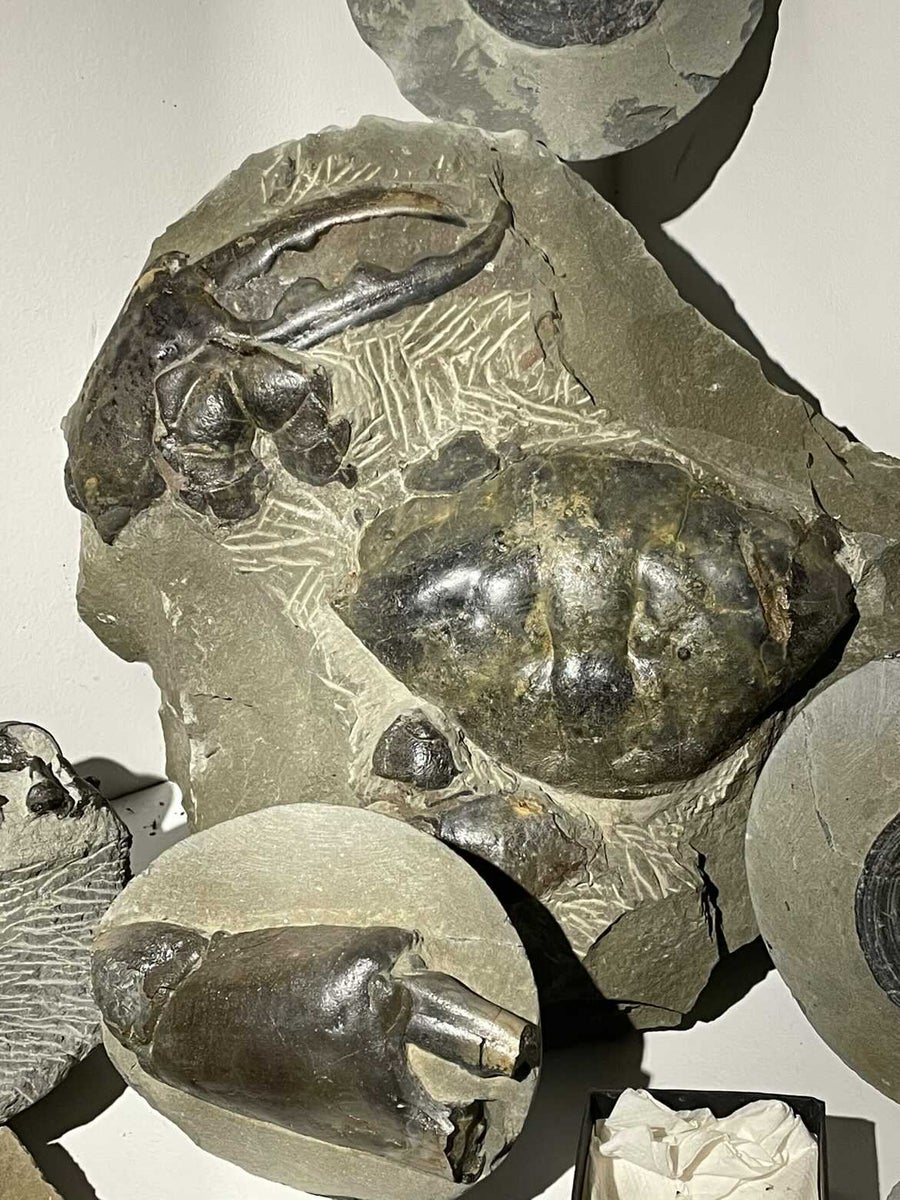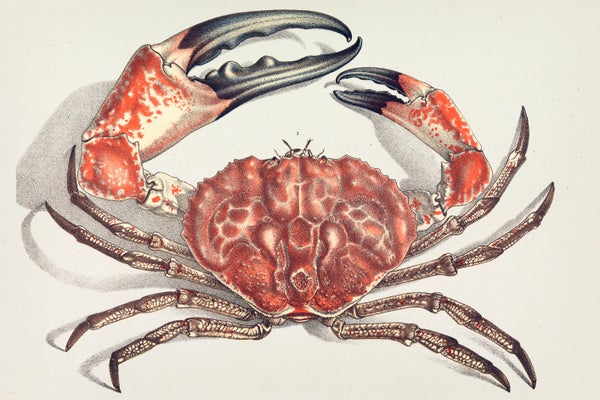It was the claw that Karl Raubenheimer spied first. The massive pincer was protruding from a rocky outcrop on a cliff-fringed beach near his home in the region of Taranaki on New Zealand’s North Island. Raubenheimer, an amateur collector then in his teens, gave the rock a few light taps, and soon the whole fossil was revealed: an enormous male crab, whole and perfectly preserved, with a 20-centimeter (eight-inch) toothed nipper that could have taken your finger off. In the following years Raubenheimer and his fossil-hunting friends found a few more remnants that seemed to be from the same species, and a decade later he unearthed another intact fossil—this time, a female.
Raubenheimer donated the two complete crabs to the Museum of New Zealand Te Papa Tongarewa and sent photographs to crab expert Barry van Bakel at Utrecht University in the Netherlands. Van Bakel could immediately tell these fossils were unlike any he’d seen before—a brand-new species of giant crab, described this week in the New Zealand Journal of Geology and Geophysics.
New Zealand is well known for giant marine crab fossils; hundreds of specimens of the species Tumidocarcinus giganteus have already been found, and adults of this species had a body averaging about 14 centimeters (six inches) across. But although this new crab lived at the same time (the Miocene epoch, around nine million years ago), its body shape was different, and it was even chunkier: the largest specimen sported an eight-inch carapace and the eight-inch claw, making it the biggest fossil crab ever found, van Bakel says.
On supporting science journalism
If you're enjoying this article, consider supporting our award-winning journalism by subscribing. By purchasing a subscription you are helping to ensure the future of impactful stories about the discoveries and ideas shaping our world today.

This fossilized giant southern crab discovered in Taranaki, New Zealand, has been designated as the species Pseudocarcinus karlraubenheimeri.
Credit: Barry W.M. van Bakel
Its only living descendant is even more spectacular. Malesouthern giant crabs (Pseudocarcinus gigas) are endowed with one oversized black-tipped pincer that, in the largest individuals, can approach half a meter (20 inches) long. These cold-water crabs are speckled scarlet and cream and can weigh as much as a small child—12 kilograms, or 25 pounds—an exhilarating armful for the commercial fishers who haul them up for export off the coast of Tasmania.
Although there is one recorded instance of a live southern giant crab caught off of New Zealand’s South Island, it had never been known to live in New Zealand, and until now scientists knew almost nothing about its evolutionary origins. “What is super cool about this fossil, besides being a beautiful fossil, is that it is from New Zealand, where we don’t really have established population of these gigantic crabs today,” says Javier Luque, an expert in crustacean evolution at the University of Cambridge in England, who was not involved in the research.
“Gigantic or not, crabs are a spectacular example of the complexities of evolution,” he adds. “They have an astonishing diversity of form and function. And in order to make sense of that current diversity, we need to take a glimpse into the past. So it is really exciting to see more fossils of this group coming to light.”
The find also tells researchers more about ancient deep-water ecosystems: the marine fossil record contains far more information about the shallows, where sedimentation occurs more than in the depths and is thus more likely to bury dead animals before they decompose. But this giant crab lived several hundred meters below the surface, where it might have been prey for early whales, dolphins and seals (whose fossils Raubenheimer and others have also found), and it was an important predator in its own right.
“When you’re large, you need a lot of energy, and you need a lot of food. How would these large crabs in a deep-water setting gather their food? There is more or less only one option,” van Bakel says.Back then this part of New Zealand was very volcanically active. Subsurface volcanoes oozed gases from seafloor vents, fertilizing the surrounding waters and attracting clams, sea snails and crustaceans—a perfect hunting ground for a giant crab with powerful pincers, van Bakel suggests.
Both Luque and van Bakel acknowledge the crucial role of amateur collectors in finding such fossils and in sharing them with the scientific community and the public. “A fossil that is not accessible to science is a fossil that does not exist,” Luque says. “It’s on us paleontologists to unearth and make sense of these words written in stone.”
More than a decade after Raubenheimer’s first find, van Bakel and his colleague have named the giant ancient crab Pseudocarcinus karlraubenheimeri. “I’m pretty stoked, actually,” Raubenheimer says of the honor. “It’s quite a special, cool crab. So I’m very, very happy with that.”
